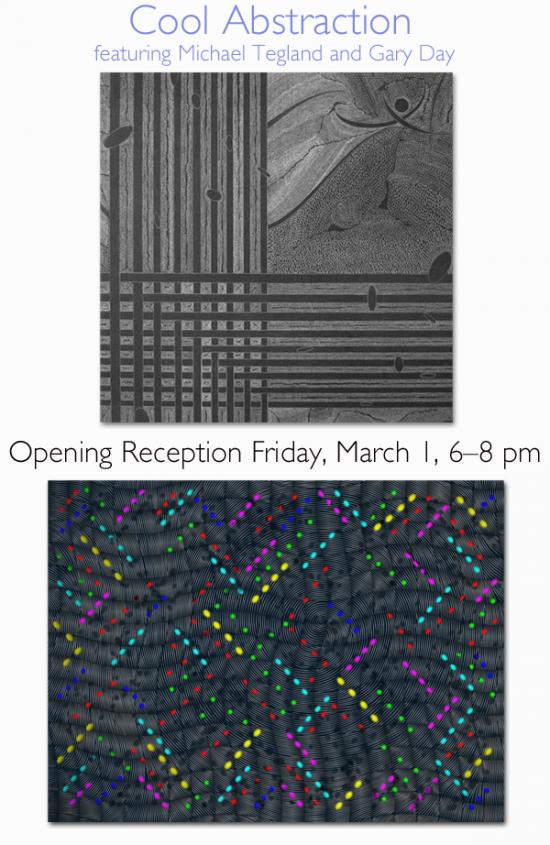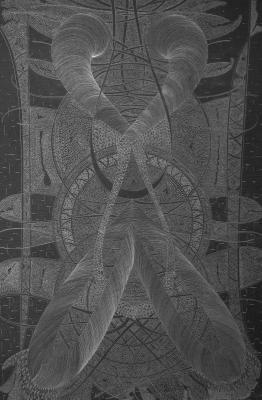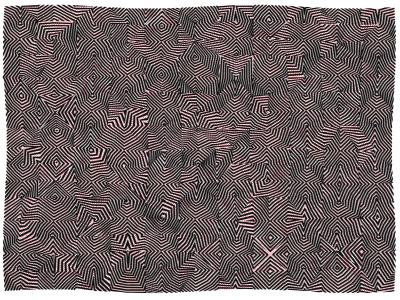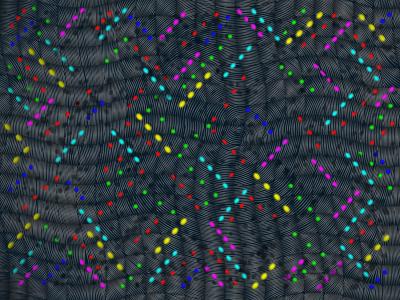March 1 - 30: Cool Abstraction showcases new work by Omaha artist Michael Tegland and UNO Professor Gary Day. Both Tegland’s graphite renderings on panel and Day’s enlarged stills of computer animations reinterpret our idea of abstraction. There is a modern detachment and distillation of our ideas about art as the idiom Cool Abstraction suggests and is further exemplified by works from John Andrews, Deon Bahr, Judith Burton, Chris Cassimatis, Colin C. Smith and Marjorie Mikasen.
Cool Abstraction
A Medium of Detached Articulation:
Drawing and Prints by Mike Tegland and Gary Day
A new two-person exhibit at Modern Arts Midtown is anchored in the past even as it explores new horizons in medium, style and point of view. Cool Abstraction features graphite drawings on matte black panels by Omaha artist Mike Tegland and the enlarged stills of UNO professor Gary Day’s computer animations.
Created each in a different process, Tegland’s traditional mark-making and Day’s contemporary digital printing share a similar distinction to other “cool” mediums as defined by noted communication theorist Marshall McLuhan, who once took the temperature of all media broadly speaking.
Abstraction cool rather than hot because the former, as McLuhan argued, provides little involvement for the audience despite substantial stimuli. Consequently, one has to engage more actively with cool media such as television and telephone in order to make a connection.
MAM owner Larry Roots, an abstract artist himself, understands the demands Cool Abstraction places on its creators and viewers alike as it “infers the conscious choice of one to dismiss familiar narratives of objectivity and explore new imagery of the mind.”
Though working in a similar vein Day and Tegland approach their subject left and right of center respectively as they draw upon science and mythology for their motivation. The first is especially true for Day whose Op-Art imagery tends to the cerebral and analytical befitting a left hemisphere approach.
“The primary image sources are entoptic phenomena which are created by migraines and other neurobiological disturbances,” he said of his work in this show. “Entoptic patterns are generated by the brain and experienced as a visual event.”
Though, technically an observer of an entoptic phenomenon cannot share his vision with another, Day is able to interpret these individual optical illusions and hallucinations, similar to recorded monocular or binocular patterns among others, into his own animated designs. This is particularly true in such works in Cool Abstraction as “Helix” with its deceptively simple geometric pattern and its two points of pulsating disturbances in the force kitty-corner from one another.
Day exhibits another side in the colorful departure of “Dancers” (think of the phenomena known as “floaters,” small moving spots in one’s field of vision) with its neon points of light layered over the artist’s signature vortices. “Dancers” also hints, Day says, at another school of thought that asserts “entoptic patterns are found in primitive art around the world” which ironically connects to Tegland’s work in this exhibit.
Compared to Day, Tegland’s aesthetic is more right brain, personal and sensual, as it references Maori tattoos, Celtic runes and Native American iconography. “Basically, my work hasn’t changed a lot, other than it’s been completely non-objective,” he says. “Also, I seem to be getting tighter in my drawing, the nib-like loop and lines. I guess, that’s the kind of language that I draw in.”
Whatever primitive source Tegland draws upon, he eschews Day’s penchant for precision analysis. Yet his admitted freer hand belies his attention to surface detail and intricate design as he alters tone on black on black panels from a matte to a metallic finish. Though the imagery, a mix of the obscure and familiar, and embedded or flowing in a web of geometric and organic patterns, is largely his own, he hopes for individual viewer interpretation.
Few local artists mix their metaphors as successfully as Tegland who appears spontaneously to have one foot in the past, the other in the future, such are his inspirations. For example, the multiple, tubular appendages in “Side Step” are one part Medusa, another part the Thing and equally menacing no matter your time reference. Similarly, “River Knows Your Name,” with its interlocking grid and sunspots, a mix of feminine swirls and masculine rigidity vacillates from primal cave paintings to the futuristic filters and portals in Chris Marker’s short film “La Jetee.”
“My thought is that my art is the connection of my wondering or daydreaming mind and my hand connecting to that thought and scribing it.”
Cool Abstraction lives up to its premise and it’s paradox of detachment and engagement. Though Day and Tegland “speak” a different language, their work puts the art in the exhibits’ articulation.
Michael J. Krainak, Free Lance Writer in the Visual Arts






